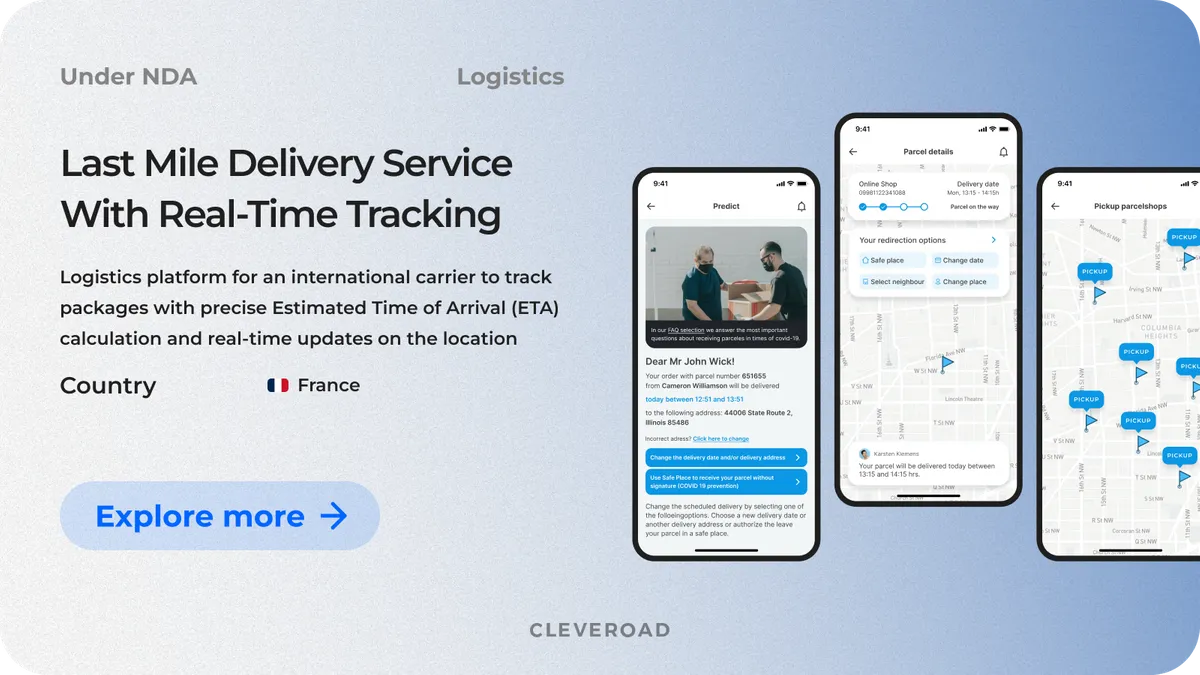Last Mile Delivery Software Opportunities and Implementation Roadmap
Updated 01 May 2025
20 Min
1912 Views
Last-mile delivery may seem like a straightforward route segment, with specialized software solutions that are equally simple. In reality, this final part is the most critical stage, where delays and route inefficiencies can directly impact customer satisfaction and cause substantial financial losses.
In this article, we’ll discuss what last-mile delivery software is, its main purpose, why businesses turn to it, and how its implementation may be helpful to optimize your logistics business functioning.
How Last Mile Delivery Software Works and Why to Utilize It?
Last mile delivery software is a convenient tool that may significantly aid you in managing, optimizing, and tracking the final leg of delivery, when a product travels from a hub to the doorstep. It combines real-time route optimization, automated dispatching, live tracking, and proof of delivery features.
Last mile delivery software helps make the final stretch of getting packages to customers faster, smarter, and more reliably. It works by assigning the best delivery routes in real time, using traffic data, order location, and time windows. Drivers get updates and directions right on their phones, while dispatchers can track progress live. It also collects proof of delivery like photos or signatures, and connects to your existing systems so everything stays in sync.
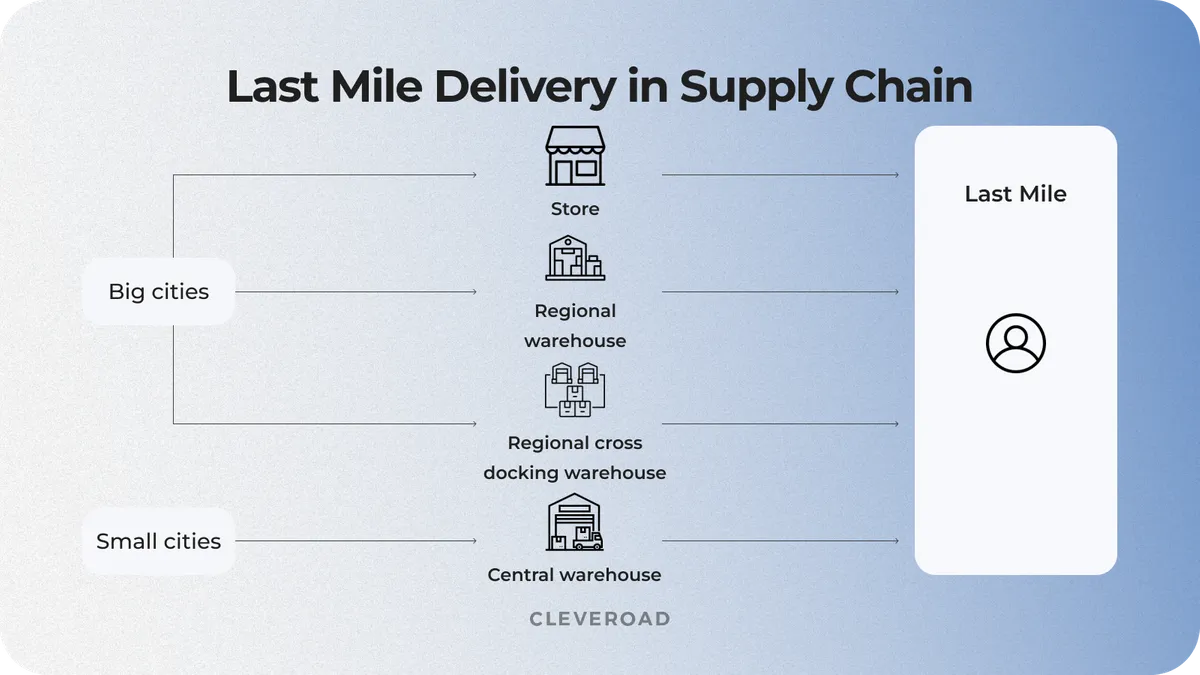
How last mile delivery in supply chain works
Types of last-mile delivery software
Last mile logistics software can serve different purposes and may be applied to multiple logistic operations. To determine what your logistics business needs to extract maximum profit, it’s essential to differentiate between key types of last-mile delivery solutions. Here are the key 4 of them below:
Route optimization software
Route optimization, as a core function of last mile delivery software, empowers logistics teams to calculate the most efficient delivery routes based on traffic, delivery windows, vehicle capacity, and real-time conditions. It helps reduce fuel costs, improve on-time delivery rates, and boost driver productivity, while adapting to unexpected delays or last-minute changes.
Delivery management platforms
Delivery management last mile software is an end-to-end solutions that handle everything from order dispatch to proof of delivery. These platforms often integrate with inventory and CRM systems, offering features like live driver tracking, automated customer notifications, and digital signatures to ensure full transparency and control over the delivery process.
Fleet management systems
Fleet management software focuses on tracking and maintaining a fleet of delivery vehicles. These systems monitor driver behavior, fuel usage, and vehicle health. Ideal for businesses operating their own fleet, they ensure compliance, reduce downtime, and extend vehicle lifespan by alerting managers to maintenance needs or inefficiencies.
Last mile delivery software market perspectives
Let’s disclose interesting market insights regarding final-mile delivery software implementation and utilization:
- According to Grand View Research, the global autonomous last-mile delivery market was valued at $1.14 billion in 2022 and is projected to reach $5.9 billion by 2030, growing at a compound annual growth rate (CAGR) of 23.5% from 2023 to 2030.
- Forbes has discussed how technology has improved first-attempt delivery rates in Western economies, with the U.S. achieving a rate of 97.8%.
- The same report by Deloitte states that more than 50% of consumers are willing to pay for same-day delivery services, highlighting the growing demand for faster delivery options.
- Zippia highlights that companies like DHL have implemented dynamic routing algorithms, such as Greenplan, resulting in 20% savings on delivery costs. Tesco's AI-powered vehicle route scheduling system has saved 11.2 million miles and achieved an 8% fuel saving per order, demonstrating the tangible benefits of integrating advanced technologies in last-mile delivery.
We provide specialized last mile delivery software development services you can use to create flexible, efficient, and accurate software solutions
Last Mile Delivery Software Benefits
Let’s take a closer look at the benefits you may get from last mile delivery software implementation.
Smarter routing
With intelligent route optimization, you’ll stop relying on static routes or driver experience alone. The final mile software uses real-time traffic, weather, and delivery windows to plan the most efficient paths. That means faster deliveries, fewer delays, and reduced fuel costs, which can cut your operational expenses roughly by up to 20%. If you're dealing with urban congestion, this is a must-have.
Real-time visibility for both parties
Knowing where your drivers are is simply essential. This software gives you and your customers live tracking updates, ETAs, and instant proof of delivery. It builds trust, cuts down on “where’s my order?” calls, and keeps your operation running smoothly. It’s a small change that considerably reduces stress within each delivery on both sides.
Improved customer satisfaction
Manual processes leave too much room for error. With automated dispatching, digital signatures, and optimized workflows, the last-mile logistics software helps ensure that packages get where they need to go, on time and to the right person. That kind of consistency not only improves customer satisfaction but also boosts retention and your brand’s reputation in a competitive space.
Why you should consider logistics mobile app development to expand your business reach? Check out our guide to learn more
Steps to Implement Last Mile Delivery Software
As a vendor with long-term experience in logistics software delivery, we’d like to offer you a comprehensive 6-step last mile delivery software development pipeline to simplify the whole process for you.
Step 1. Assess operational needs and delivery constraints
Start by taking a hard look at how your last-mile operations currently run – everything from driver routes and order volume to delivery zones and customer expectations. This phase is all about identifying pain points and defining what success looks like. You'll want to clarify specific delivery KPIs, regulatory considerations, and tech limitations before building anything.
Step 2. Find a credible IT vendor
When planning to create a last-mile management software, one of the most critical decisions you’ll make is selecting a reliable IT partner. The logistics domain comes with its own set of complexities – from route optimization and real-time tracking to CRM integration and compliance. Working with a credible software vendor experienced in logistics solutions is key to building tools that actually solve real-world problems and support long-term growth.
To classify and review vendors effectively, go through platforms like Clutch or Goodfirms to research their past collaboration experiences, client ratings, and reviews. Be sure to review the chosen vendor’s portfolio to assess the quality of their work and how well their past solutions align with the specific challenges your logistics business is looking to solve.
For example, at Cleveroad, we have a proven track record in software delivery for the logistics industry. One such example is our project with Occaz, a European company offering a car inspection and logistics assistance platform. They needed an IT partner to create an app to digitize vehicle checks, streamline documentation, and offer registration and warranty services within a mobile solution.
We delivered native iOS and Android apps, a custom CRM, and a smart report generation engine based on user input. As a result, the client launched a feature-rich platform that automates processes, reduces admin overhead, and supports scalable business growth in the automotive logistics space.
Here’s what Jérémy Chicard, founder of Occaz, says about collaboration with us:
Jérémy Chicard
Founder of Occaz
What Cleveroad and the team on our project managed to do is simply bring it to the next level. With methods, enthusiasm, and great skills, they put our idea into a spaceship that will hopefully reach the speed of light. We heavily recommend the company and are still working with them on the next steps.
Step 3. Map out integration points with existing tools
To ensure your last-mile delivery software becomes a fully embedded part of your logistics ecosystem, not a standalone tool, you’ll need to define a robust integration strategy early on. This includes identifying what features will interact with other systems, determining the necessary platforms for deployment (web, iOS, Android, etc.), and setting performance expectations for each environment.
Your development team will help evaluate integration needs across departments and user roles, outlining technical requirements such as APIs, authentication protocols (OAuth 2.0, JWT), and secure data pipelines. The goal is to enable real-time sync and consistent data exchange without compromising system performance or user experience.
Typical integrations for last-mile delivery software include:
- ERP systems, e.g., SAP, Microsoft Dynamics for resource and order management
- CRM platforms like Salesforce can align delivery with customer communications
- Warehouse Management Systems, like NetSuite, for dispatch coordination
- Route APIs such as Google Maps or HERE for navigation and route optimization
- Payment gateways like Stripe, PayPal, and Adyen for COD processing and invoicing
- 3PL services such as Shippo, EasyPost, or FedEx APIs for carrier coordination
- Asset and fleet tracking systems, including Asset Panda or Verizon Connect
- Communication tools such as Twilio or SendBird for live chat, and notifications
We provide logistics software development services and facilitate numerous third-parties like Google Maps, Hubspot, Shiptify, and more. Check out service page to learn more
Step 4. Go through development and QA
Once you’ve chosen the vendor, gone through strategic sessions and gathered essential requirements, the last mile delivery software development starts. At this point, your development team gets to work building the core features, such as route optimization algorithms, real-time tracking, ETA calculations, and delivery status updates. Quality assurance (QA) plays a critical role in making sure your app works flawlessly across devices and conditions, especially under real-world logistics loads.
Step 5. Collect feedback from all user roles
After internal QA, your development team will help you release last mile routing software to a pilot group of real users – dispatchers, drivers, warehouse staff, customer service reps, and even a few end customers, if applicable. Each group will have to interact with the system differently, so their input is critical for revealing friction points, workflow inefficiencies, and overlooked edge cases. Apart from this, use surveys, interviews, and session recordings to gather both qualitative and quantitative feedback that can directly inform the next development phase.
Step 6. Iterate and scale gradually
With real-world insights in hand, you can freely begin to refine the platform. You can continue to collaborate with your team to adjust route optimization logic, improve system responsiveness under load, or simplify the UI for driver-side apps. At this stage, focus on stabilizing the core experience before scaling. Once KPIs like delivery time, error rate, and user satisfaction hit target thresholds, confidently expand to new operational zones, larger fleets, or added delivery models, without overwhelming your team or compromising reliability.
Last Mile Delivery Software Functionality Modules
Now, let’s look at the must-have features that should be added to every last mile logistics software. Every last mile delivery software must address the roles of the three different stakeholders:
- Consumer
- Driver
- Dispatcher**
So, there are separate modules that must be built to cater to the needs of their respective groups.
Modules for consumers
The customer-side functionality is essential for users to receive insight into their package's status. Let’s see the features essential to facilitate a seamless user experience:
Notifications module
This functionality enables the sending of automated alerts to users within last-mile delivery software. These alerts are designed for enhanced package delivery status tracking, providing estimated arrival times and notifying users about potential route issues or delivery delays. The Notification module enhances communication between the company and the customer throughout the process.
Real-time driver tracking
This feature makes delivery operations more transparent, enabling you to monitor the courier's location and progress at any given time. Additionally, real-time visibility enhances control over vehicles and delivery drivers, resulting in improved efficiency, better customer service, and the ability to promptly address any issues that may arise during the delivery process.
Support
Robust support is always the right approach to building trust with your customers. Moreover, this may help businesses swiftly resolve any issues or questions that users may experience during delivery operations. Besides enhancing customer satisfaction, you, as a transportation business, will be able to reduce workload and optimize management operations.
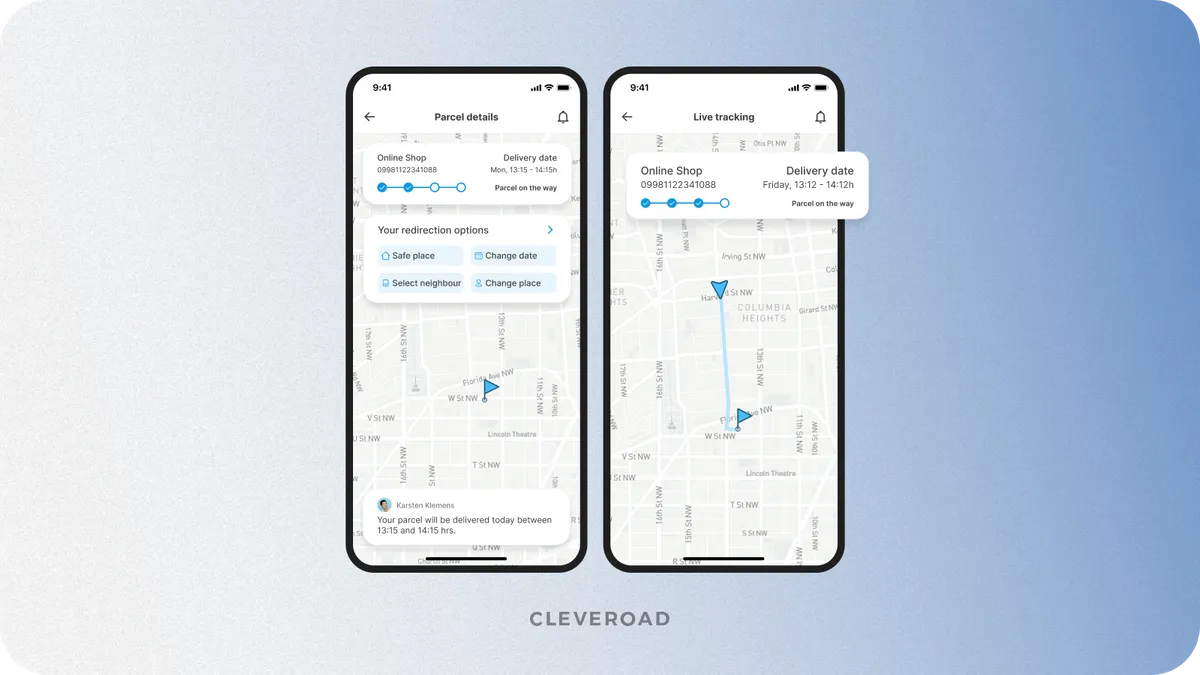
Last mile delivery software customer interface designed by Cleveroad
Modules for drivers
Functionality module for drivers is essential to facilitate smooth and efficient delivery processes. So, let’s discover the purpose of each element of drivers' functionality:
Proof of delivery
In the last mile delivery platform, electronic proof of delivery, such as in-app signatures, images, timestamps, and geo-coordinates, is essential for enhancing transparency and customer trust in the delivery process. These digital records not only serve as concrete evidence of successful deliveries but also provide trustworthy verification of receipts, resolution of disputes, and generally safeguards the drivers from the legal perspective.
Route updates
This functionality offers real-time updates to the driver's predefined delivery route. This may appear necessary in case of heavy traffic load on a particular section of a road, road closures, or new delivery requests. This tech solution allows to orient drivers in these updates, through guiding them and giving instruction using GPS or mobile devices.
Live chat
A live chat for drivers allows real-time communication with dispatchers and customers. In case of unexpected schedule changes or road occurrences, a driver can update the dispatcher. Also this feature enables efficient problem-solving, enhances safety, while reducing distractions during driving.
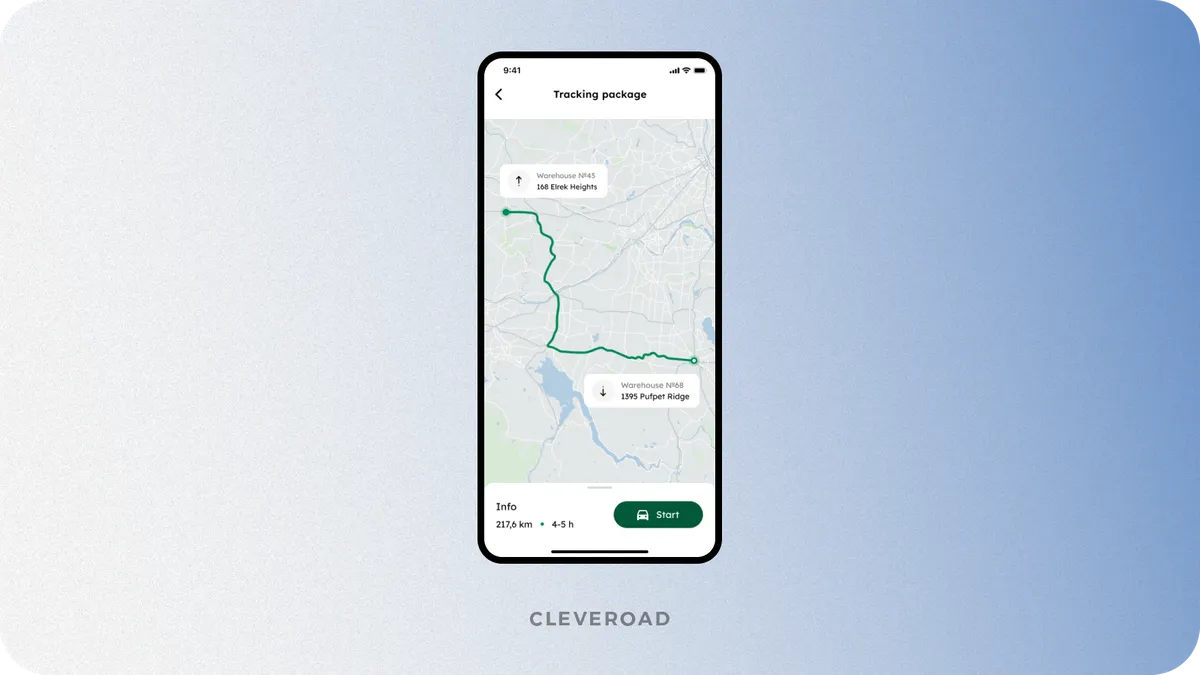
Last mile delivery software driver interface designed by Cleveroad
Modules for dispatchers
Dispatchers are the connective link between the driver and a customer in your final mile delivery software. The Dispatcher’s module is required to optimize the delivery process by assigning, tracking and coordinating delivery tasks. See the key dispatcher-side functionality below:
Estimated time of arrival calculation
ETA (Estimated Time of Arrival) calculation significantly helps to navigate drivers more efficiently. It enables carriers to stay on schedule, avoid unnecessary rush, ensure safety, and communicate realistic arrival times to customers. All of this contribute to smoother and more successful deliveries.
Data generation
Having data helps logistics enterprises make more conscious decisions. An application generates critical business metrics like success rates, service time, distance traveled, feedback scores. This functionality serves to provide real-time updates, helping dispatchers accurately manage deliveries, track drivers, optimize routes, and ensure timely and precise order fulfillment.
Route planning
This last mile tracking software feature allows the dispatcher to determine the most fuel-efficient paths to the final destination. An automated route planner analyzes numerous variables, including traffic congestion, road conditions, and vehicle solutions.
Delivery rescheduling
Customers appreciate the opportunity to cancel their delivery and reschedule it in case of an emergency, so dispatchers must try to accommodate such requests promptly. The main purpose of the delivery rescheduling is to enable dispatchers to efficiently adjust and optimize delivery schedules in response to changing circumstances. It helps in managing unexpected occurrences and accommodating customer requests, improving delivery efficiency and contributing to customer satisfaction.
Real-time fleet tracking
This feature enables dispatchers to accurately monitor the exact location of a vehicle. Through continuous tracking, the dispatcher can ensure that the driver adheres to the delivery schedule and follows the most efficient route previously planned. The specialist can also track drivers' driving behavior, ensuring the avoidance of dangerous road situations.
There are a lot of final mile delivery software options on the market. Not all, however, are managed to cover your specific business needs. For example, a solution for last mile logistics in New York City might look very different from the best solution in Paris. So it’s better to focus on custom app development to get software that fits your last mile delivery logic.
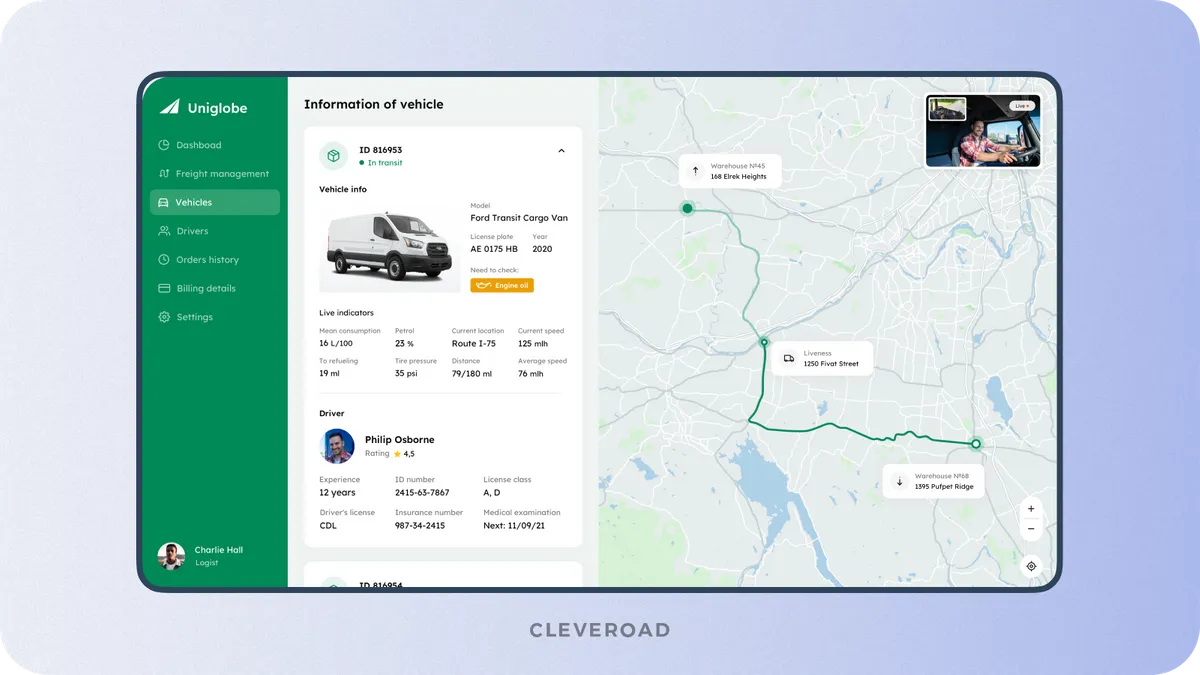
Last mile delivery software dispatcher interface designed by Cleveroad
Last Mile Delivery Solutions in Action: App Demo
Planning to build your own last mile delivery app, you probably want to see it in action to get a sense of its capabilities. Our team has designed a demo version of the application, so you can see how the mobile app for Last Mile Delivery works

Popular Last Mile Delivery Solutions
Here are four popular examples of last-mile optimization software and their key features you can look at before creating your own logistics solution.
LogiNext Mile
LogiNext Mile is a logistics software solution that offers a range of features designed to optimize delivery operations. Engaging predictive analytics, the software is capable of precisely predicting delivery time, helping businesses to make more informed decisions.
The functionality of this solution includes route planning and optimization, real-time monitoring of vehicles and deliveries,and electronic proof of delivery. This last mile management software is widely used among businesses to improve the effectiveness of their delivery processes, reduce costs, and enhance customer service.
Track-POD
Track-POD refers to a cloud-based delivery and logistics management platform that helps companies optimize and automate their delivery processes and improve customer service. With Track-POD, companies can manage their orders, routes, track shipments in real time, and improve the efficiency of their delivery operations and reduce costs.
E-Courier CMS
E-Courier is a cloud-based platform that logistics companies use to effectively track their shipments from origin to destination, ensuring complete transparency and strict accountability throughout the delivery process.
The software's integration capabilities allows smooth collaboration with partners, carriers, and suppliers, streamlining the entire processes in the whole supply chain. Also, the last mile delivery software supports the barcode scanning, in case it’s needed to swiftly find the necessary package of even specific items. By using data and analytics, E-Courier empowers businesses to improve route planning, reduce costs, and ultimately expand their logistics operations.
FarEye
Generally, FarEye is a technology company that offers a wide range of logistic tools and even platforms for companies to simplify and optimize their delivery processes. Their platform provides features to facilitate real-time visibility of vehicle and packages, and gives an ability to integrate the software into existing e-commerce solutions and TMS systems.
Besides they engage last mile delivery AI and Machine Learning to predict delivery times and also FarEye software may be customized to the businesses specific needs and branding, ensuring personalized experience.
Last Mile Delivery Software Implementation Challenges
In the next section, we’ll discuss the most common pitfalls of implementing last-mile delivery software and strategic ways to reduce risks and prevent issues before they arise.
Ensuring data security across multiple stakeholders
With drivers, customers, admins, and external partners accessing your last-mile platform, the attack surface grows. If your software isn’t architected with strict access control, data encryption, and audit trails, you're risking customer privacy leaks, regulatory violations, and vendor-side breaches. Security can’t be an afterthought when everyone touches sensitive data.
Cleveroad expert tip: We follow OWASP Top 10 and NIST Cybersecurity Framework standards for system design. Cleveroad implements AES-256 encryption, JWT-based authentication, and OAuth 2.0 for secure access across roles. We also ensure compliance with GDPR, CCPA and leverage Amazon Cognito, Azure Active Directory, or custom IAM modules for managing secure identities and access permissions – making our solutions well-suited for a secure last mile delivery tracking platform.
Handling high delivery density in urban areas
When you’re delivering across a packed city, traffic, tight delivery windows, and clustered addresses can cripple route efficiency. Without real-time optimization, delays stack up fast, affecting customer satisfaction and operating costs. Urban areas often require multi-drop planning, dynamic rerouting, and geo-fencing, all of which demand advanced routing logic and a well-integrated dispatch system.
Here’s what Daria Yukhymenko, Cleveroad delivery manager, has in mind on this:
Daria Yukhymenko
Delivery Manager
In dense urban areas, the key is designing delivery software that can handle real-time inputs, traffic flow, delivery clusters, parking restrictions, and still make optimized routing decisions fast. Without that, delays stack up and efficiency drops quickly.
Cleveroad expert tip: We build custom route optimization engines using Google Maps Platform, GraphHopper, or HERE API, combined with AI-based clustering algorithms to handle complex multi-drop patterns. Cleveroad integrates real-time traffic updates and geofencing into dispatch systems using Firebase, WebSockets, and MQTT protocols, ensuring drivers adapt instantly to changing road conditions. As part of a robust last mile delivery management solution, this approach helps increase deliveries per hour while reducing operational friction in dense metro areas.
Balancing customization with update compatibility
Everyone wants software tailored to their operations, but going too custom can break compatibility with vendor updates or 3rd-party tools. Over-engineered custom features make it harder to scale, maintain, or onboard new tech later – especially if the system becomes too tightly coupled to current workflows or devices.
Cleveroad expert tip: We design software with microservices architecture, often using Node.js, Spring Boot, or .NET Core, and isolate business-critical features behind APIs to reduce interdependencies. Cleveroad adopts Kubernetes for container orchestration and uses RESTful and GraphQL APIs to ensure integrations remain stable and modular. This makes it easier to evolve even the best last mile logistics software without costly redevelopment or downtime.
Managing battery and connectivity limits on driver devices
Delivery drivers rely on smartphones or rugged tablets, which face spotty LTE signals, battery drain from real-time GPS, and app crashes under poor optimization. If your delivery app isn’t lightweight, offline-ready, and power-efficient, it’ll frustrate your team – and may even cause delivery failures.
Cleveroad expert tip: We develop native apps using Kotlin for Android and Swift for iOS, with offline-first architecture supported by Room Database, Core Data, and WorkManager for background syncing. For location services, we optimize GPS polling intervals and use Fused Location Provider API to minimize battery use. Cleveroad tests apps across device types using Firebase Test Lab and applies Crashlytics and Appium to ensure performance is stable in low-signal environments – exactly what you’d expect from a resilient last mile optimization software solution.
Cleveroad – Your Credible Partner in Last Mile Delivery Software Implementation
Cleveroad is a logistics software development company with 13+ years of experience helping transportation and delivery businesses streamline operations, cut costs, and elevate customer satisfaction with tech engagement. We create custom last mile delivery solutions designed to handle real-world complexities, from dense urban delivery zones to rural drop-offs with limited connectivity.
Cleveroad provides customized logistics solutions with key features including real-time GPS tracking, ETA updates, and dynamic fleet management. Our systems also support autonomous deliveries via drones and robots. We enable digital proof of delivery with barcode scans, e-signatures, photos, and geotags. We also implement integrations with the industry’s most trusted logistics tools like Google Maps, Salesforce, Shippo, HubSpot, and Asset Panda, ensuring your platform seamlessly connects with your existing ecosystem.
Here are the benefits you gain by working with us:
- Cleveroad is certified with both ISO/IEC 27001:2013 (information security) and ISO 9001:2015 (quality management) to facillitate delivery of secure and top quality solutions.
- Our teams provide full-cycle development. We conduct technical audits, manual and automated testing, CI/CD delivery, and offer ongoing DevOps and infrastructure support.
- Our engineers build complex, fault-tolerant logistics systems with real-time tracking, IoT integrations, API design, and cloud-native services.
- You can partner with us through IT staff augmentation, a dedicated development team, or full-cycle project outsourcing whichever best fits your technical bandwidth and business roadmap.
We have an extensive portfolio with various cases of software delivery for logistics domain. To represent our expertise, we'd like to show you some vibrant examples.
Transportation management system
We’d like to show you our vibrant case for business in the logistics domain – Route Planning and Transport Management System for an US-based warehousing and cargo long-distance delivery.
Cleveroad collaborated with a logistics provider offering long-haul delivery, warehousing, and last-mile services for marketplaces. The client needed a custom transportation management system (TMS) with automated route planning, integrated into their existing infrastructure to streamline operations and reduce manual workload.
We delivered a fully integrated logistics solution featuring intelligent route optimization with manual adjustments, a real-time control module, and a mobile app for drivers. Our team also built a complete TMS covering fleet and delivery point management, while integrating warehouse and CRM systems for full automation.
As a result, the client minimized delivery times, reduced overhead costs, and increased ROI per vehicle. With all logistics processes unified, they gained full operational control and scalability.
Last-mile delivery solution
Another case we worked on is a Last-Mile Delivery Service with real-time tracking, built for a global parcel delivery company with over 20 years of experience in international B2C shipping.
The client approached us to expand their logistics ecosystem with a customer-facing mobile solution focused on enhancing the last-mile delivery phase. Our team developed a cross-platform app from scratch, enabling users to track parcels in real-time on a map, view status updates, and receive delivery notifications. Distinctive features included real-time geolocation tracking, a unified status interface, and seamless system integration to ensure data consistency across logistics operations.
As a result, the client received a fully integrated, scalable last-mile delivery solution that enhanced their delivery experience, increased customer satisfaction, and reduced support workload. The app helped increase retention rates, reduced delivery uncertainties, and created a reliable digital touchpoint that contributed to operational efficiency and measurable revenue growth.
Build a reliable last mile delivery software with us
Our logistics matter expert will reach out within 24 hours to learn about your last-mile project and schedule a strategy call with tech experts to outline requirements and map the development pipeline
Last mile delivery software is a digital solution that helps manage and optimize the final leg of a delivery, getting goods from a transportation hub to the end customer. It supports route planning, real-time tracking, proof of delivery, and driver communication.
The cost varies based on features, user count, and whether it's custom-built or off-the-shelf. Custom solutions typically start at $50,000+, while subscription-based tools can range from $100 to $500+ per month per user.
An example would be a local courier delivering a customer’s online order, like groceries or a package – from a nearby distribution center directly to their doorstep.
The biggest challenge is balancing speed and cost efficiency, especially in urban areas with heavy traffic, tight time windows, and high delivery volumes, all of which increase complexity and operational expenses. To maintain a comprehensive last-mile delivery workflow, logistics businesses must rely on feature-rich last-mile delivery software that not only tracks delivery status in real-time but also streamlines last-mile delivery operations. Leveraging last-mile delivery management software with features such as route optimization is crucial for improving resource utilization, reducing delays, and enhancing delivery performance at scale.
New trends in last-mile delivery include the rise of autonomous delivery (utilizing drones and robots), AI-powered route optimization, real-time delivery tracking for customers, green logistics with electric vehicles, and micro-fulfillment centers in urban areas to expedite timely delivery. Additionally, integration with delivery management software and the use of predictive analytics are becoming key to improving efficiency and customer satisfaction.

Evgeniy Altynpara is a CTO and member of the Forbes Councils’ community of tech professionals. He is an expert in software development and technological entrepreneurship and has 10+years of experience in digital transformation consulting in Healthcare, FinTech, Supply Chain and Logistics
Give us your impressions about this article
Give us your impressions about this article



